5P85 TEL (S-300 PMU)
 Soviet Union
Soviet Union
SAM Telescopic Erector Launcher Truck (1978) - circa 650 built
The S-300 SAM carrier
The 5P85 is a family of missile launch vehicles, based on the MAZ-543 8x8 standard heavy truck of the Soviet Union. The 5P85 is the global name for the weapopns system associated with the S-300 long-range missile, as a mobile air defense system. It was developed in the Soviet Union by the late the 1970s. This Transporter, Erector and Launcher (TEL) vehicle had its first version 5P85ME introduced in 1978, followed by others, and largely sold abroad to about 19 operators, and all but two of them still had them in their inventory. Russia today alone had 352 vehicles active in the 2000s. They took part in many operations and wars. During the invasion of Ukraine in 2022, two were lost as of today.
About the S-300 SAM family
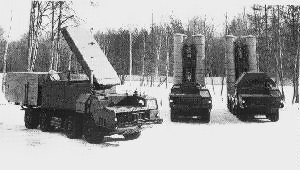
The S-300 (Initial NATO reporting name SA-10 Grumble) is a series of long range surface-to-air missile systems developed in Soviet Union by the 1970s, produced by NPO Almaz based on the initial S-300P system. The project-managing developer, Almaz-Antey developed the whole weapons system, but the missile themseves were developed by MKB "Fakel" and NPO Novator design bureaus (previous "OKB-2" and "OKB-8").
The S-300 was to be deployed top counter high altitude bomber air raids, shoot down spoy planes and and intercept cruise missiles. In time, more precise versions will be devoted to ballistic missiles interception. The S-300 system development started in 1979 for the air defence of large industrial and administrative facilities and military bases as well as airspace control, fully automated but with manual observation and operation as a backup.
It can be remotelly operated from fixed positions from a central command post up to 40 km away and the associated radars up to 80 km apart provides target designation for the central command post. The command post then compares data received from the targeting radars while filtering false targets. The system was designed for both active and passive target detection modes. It was also further developed into a naval version by MNIIRE Altair (Marine Scientific Research Institute of radioelectronics) as the S-300F or NATO SA-N-6 "Grumble".
As of today this system is regarded as one of the world's most potent missile system fielded, used in Asia, Eastern Europe and even operated by NATO member Bulgaria and Greece. It was superseded well after the fall of the Soviet Union by the S-400 (NATO SA-21 Growler) from 28 April 2007.
S300P - SA-10 Grumble (1978)
The initial missile system, called S-300PT (NATO SA-10A) is the original version operational in 1978, and by 1987, over 80 were active mainly around Moscow. Eacg unit consists of:
- 36D6 (NATO TIN SHIELD) urveillance radar
- 30N6 (FLAP LID) fire control system
- 5P85-1 launch vehicle
The 5P85-1 vehicle, a semi-trailer truck provides support for four missiles, deployed as a TEL, vertically at the rear of the vehicle. Organically each battery usually comprises three 5P85-1 trucks and a single 76N6 (CLAM SHELL) low altitude detection radar also carried by the same MAZ-543 platform.
The S-300PT uses a passive electronically scanned array radar to engage multiple targets, with the same single fire-control system. Deplyment is done once the truck is stopped in about one hour dfoe the full set up and fire. To avoid scorching the rear of the TEL, launches are spaced by several minutes. It is compensated by the simultaneous fire of three trucks.
The system was originally intended to use the Track Via Missile (TVM) guidance system but it's inability to track targets below 500 m had it postponed. To improve this, a new command-guidance system was added for the initial flight guidance, as low as 25 m altitude for low-flying strike aircraft.
Improvements to the S-300P resulted in many variants, including simplified ones for the export markets.
-The S-300PT-1 (SA-10B)
-S-300PT-1A (SA-10C).
Both had the new 5V55KD missile, cold launch method and 30 minutes readiness, plus trajectory optimizations to reach 75 km.
S-300PS/S-300PM (NATO SA-10D/E Grumble) 1985
Next came the introduced in 1985. It was developed to carry a nuclear warhead and a more modern TEL and mobile radar plus command-post vehicles based on the MAZ-7910 8×8 truck (1980) instead of the MA-543A introduced in 1967. This model featured the new 5V55R missiles reaching 90 km (56 mi) and terminal semi-active radar homing guidance mode (SARH), associated radar system 30N6. The towed TEL is designated 5P85T, the Mobile TELs are the 5P85S and 5P85D. The second is a "slave" TEL controlled by a 5P85S identifiable thanks to the taller equipment container behind the cabin. On the "slave" it is not enclosed and used for cable or spare tyre storage.
S-300PMU (NATO SA-10F Grumble) 1992
The next modernization was introduced in 1992, but for the export market and still with the upgraded 5V55U missile with intermediate SARH terminal guidance method, smaller warhead but roughly the same range and altitude as the new 48N6 missile, of 150 km or 93 miles. The associated radars are the 64N6 (BIG BIRD) and illumination/guidance radar GRAU index 30N6-1.
All in all, S-300P systems (all combined) reached circa 3,000 launchers; 28,000 missiles with their individual canisters by 2012. This does not meant 3,000 TELs as many are also towed or fixed.
S-300PMU-1/2 (NATO SA-20A/B Grumble) 1993
The S-300PMU-1 (SA-20A Gargoyle) arrived in 1993 with the larger 48N6 missile with the same performances as the S300PM, smaller warhead than the naval version at 143 kg (315 lb) and coupled with the 30N6E (NATO TOMB STONE) radar. In addition to the 5V55R and 48N6E missiles, the S-300PMU-1 used the 9M96E1 and 9M96E2, smaller missiles at 330-420 kg (730 and 930 lb) with small 24 kg (53 lb) warhead and 1–40 km (0.62–25 mi) or 1–120 km (0.62–75 mi) range. They used aerodynamic fins and gas-dynamic system for excellent Pk still at 0.7 against a tactical ballistic missile.
It was coupled with the 83M6E command and control system including the 64N6E (BIG BIRD) surveillance/detection radar and 30N6E(1) control/illumination and guidance radar, plus a 76N6 low altitude detection radar and 96L6E all altitude detection radars, both tracked. The 83M6E CiC can control up to 12 TELs, of the 5P85SE/5P85TE type. Each unit included a 40V6M tow vehicle for support and lifting the fixed antenna post.
The S-300PMU-2 (SA-20B) was introduced in 1997, but presented in 1996 with a 195 km (121 mi) range and 48N6E2 missile also able to shoot down medium range ballistic missiles. The CiC is the 83M6E2 with the 54K6E2 CP vehicle, 64N6E2 surveillance/detection radar, 30N6E2 FC/IG radar. Same for control, 12 with 5P85SE2 TEL and/or 5P85TE2 trailer launcher. Occosionally coupled with the 96L6E all altitude + 76N6 low altitude detection radars, both tracked.
From missilery.info/: "The universal mobile multi-channel anti-aircraft missile system C-300PMU-2 "Favorit" is designed to defend the most important assets, its armed forces, from massive strikes of modern and advanced aircraft and strategic cruise missiles, tactical and operational-tactical ballistic missiles or any other air attack with varying the range and speeds and in any conditions, including when exposed to intense active and passive interference.
The S-300PMU-2 Favorit system is a further development of the S-300PMU-1 with increased compabt capabilities with the new 48N6E2 missile with increased efficiency for hitting ballistic targets at 40 km, ensuring the detonation of the target’s warhead with greater zone of destruction and in a 200 km range, including in pursuit and a radar and CiC system enabling to shoot and track and the same time tup to 12 simultanoeus targets. The detection characteristics of the system ere improved in combat operations by using the new target designation radar 96L6E, using the 48N6E ZRS S-300PMU-1 missiles along with the 48N6E2 missile, and even NATO standards compatibility. Created in 1995-1997 it was developed and improved by NPO Almaz and now offered to the export market."
Performances (S300 PMU)
- Range: Aerodynamic target 5–90 km
- Range: Ballistic targets 35 km
- Height defeat: vs. Aerodynamic target 0.025–27
- Maximum target speed in m/s: 1,150-1,300
- Maximum speed in m/s: 2,000
- Number of simultaneously guided by one unit: 12
- Number of simultaneously engaged targets by single unit: 6
- Mass, rocket, kg: 1,400–1,600
- Warhead weight, kg: 150
- Minimum time between launches: 3–5 sec.
- Set up time and clotting time of starting: 5 min.
5P85-1 specifications: MAZ 543
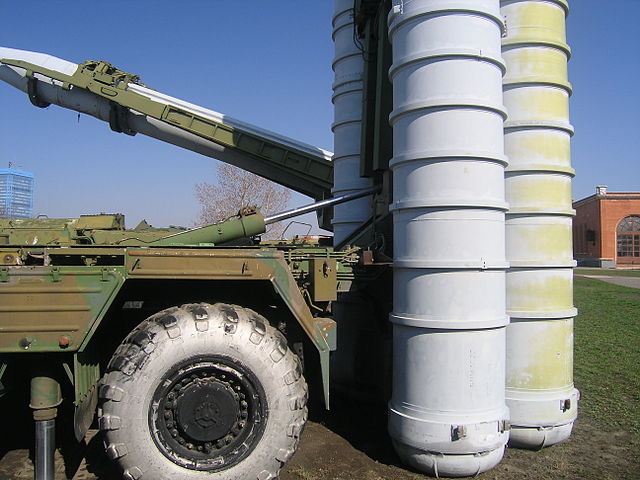 S-300P Tel 5327 detail
S-300P Tel 5327 detail
Part of the wide family of 8x8 heavy duty military trucks designed in the 1960s primarily as a multipurpose platform, TEL and RL platform, radar, chemical, mine warfare and other use. The MAZ-543 was also called MAZ-7310 "Uragan" and comprised the MAZ-543 (1965) general purpose platform, MAZ-543A with extra payload and variant MAZ-7310 with 4WD MAZ-8385 trailer for Siberian service, but also the MAZ-543M (BM-30 Smerch), MAZ-543P with the 9K72 Elbrus launcher (9P117), and for SAMs, the MAZ-7910 carying the S-300 PMU-2, and the MAZ-74106 with the air search radar 64N6 BIG BIRD (future article). But also the 6x6 MAZ-547, coupled with the with RSD-10 Pioneer IRBM an the Chinese 8x8 WS2400.
The MAZ 543A/543M were built with fiberglass side cabins, different front radiator and cab split, plus different cabin interiors. Wheelbase was 7.7 meters, top speed 60 kph with 80 liters per 100 km. These two twin-door cabins left and right had excellent visibility and intercom. The more evolved MAZ-7910 had not right cabin, only left.
Their MAZ V12 engine had a 38.8 liter capacity for "just" 525 horsepower, independent torsion bar suspension and telescopic shock absorbers, centralized tire inflation system. On the 7910, wheelbase was increased to 7,7 meters with a 2,375 mm track.
5P85D/S/PMU specifications: MAZ 7910
 SA-20 missile complex.
SA-20 missile complex.
In 1974, MAZ made the pipe hauler MAZ 7910 prototype, with production starting in 1976 with its single cabin. Overall dimensions 11,450 x 3,050 x 3,550 meters and curb weight was 23,300 kg. Payload was 18 tonnes and top speed under 60 kph. It used the D12A-525 V-12 water-cooled diesel engine also rated at 525 hp at 2,100 rpm, giving it a 26.25 hp/metric ton power to weight ratio, Maximum Speed Off-Road of just 30 kph, and 800 km range;
5P85TE2:
Also close to the 5P85SE2 it was built by Almaz-Antey Concern and introduced April 28, 2007 as a 10x10 wheeled missile launching vehicle associated with the S-400 long-range air defense system, carrying each four 48N6E2 or 48N6E3 surface-to-air missiles and/or two 40N6E very long-range surface-to-air missiles or even 12 9M96E or 9M96E2 high maneuverable missiles. 48N6E and 9M96E could be operated in combination, and each launcher could accomodate three 9M96E missiles.
5P85 Variants
5P85-1: Initial TEL based on the MAZ-543
5P85D: "slave TEL" Based on the improved MAZ-7910, for the S-300PM
5P85S: "master TEL" also based on the MAZ-7910 for the S-300PS
5P85SE/TE: MAZ-7910 based vehicle for the 9M96E1 (S300 PMU-1)
5P85TE2: MAZ-7910 based vehicle for the 9M96E2 (S300 PMU-2)
MAZ-74106: Air search radar vehicle for the 64N6 BIG BIRD/S-300PM.
HQ-15: Chinese PLA variant of the second
5P85 Operators
 Slovak S-300PS and 5V55R
Slovak S-300PS and 5V55R
 Ukrainian vehicles in the 2014 Kiev parade
Ukrainian vehicles in the 2014 Kiev parade

 Kazakh S-300 TEL
Kazakh S-300 TEL
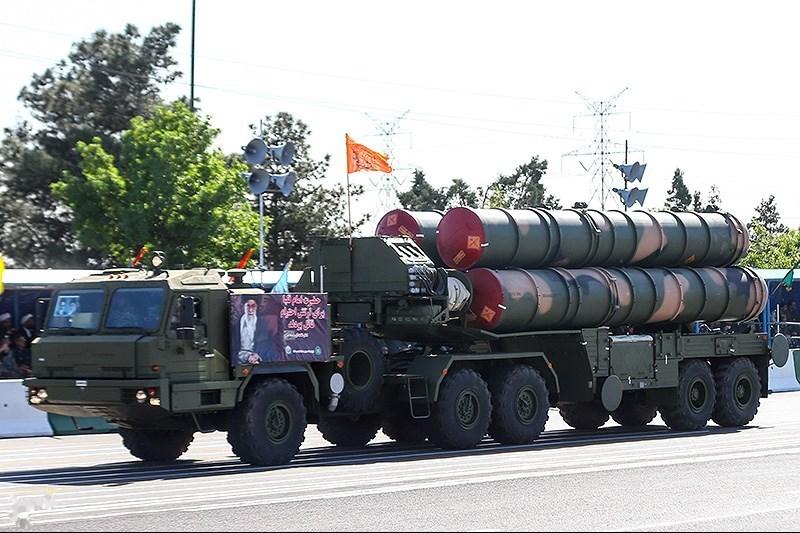 S-300 missiles on a 6x6 Iranian trailer truck, Tehran parade, army day
S-300 missiles on a 6x6 Iranian trailer truck, Tehran parade, army day
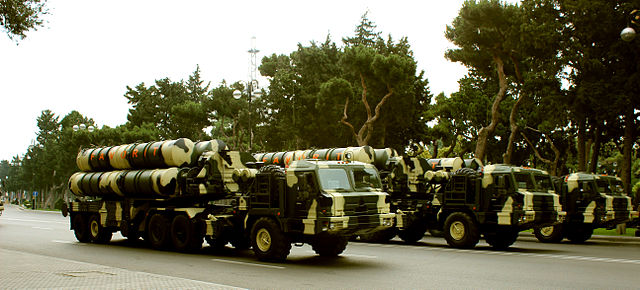 favorit missile system at the Military parade in Baku 2013
favorit missile system at the Military parade in Baku 2013
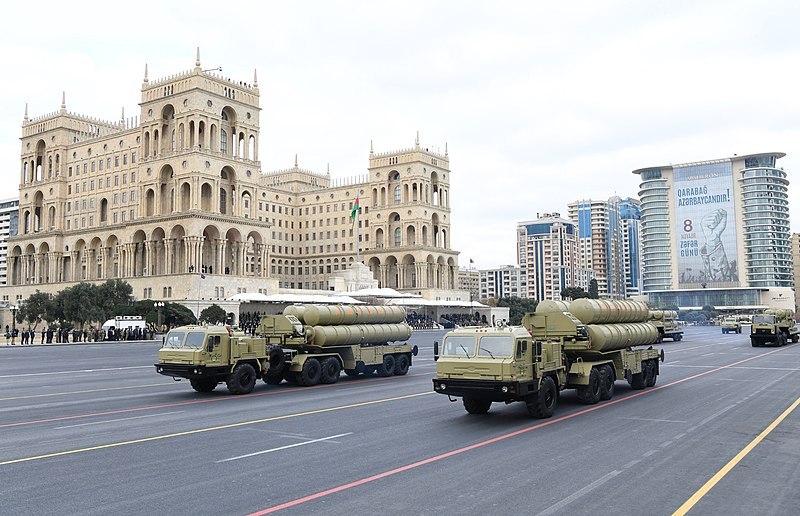 Azeri 2020 Parade, S-300PMU2, 5P85TE2 trucks
Azeri 2020 Parade, S-300PMU2, 5P85TE2 trucks
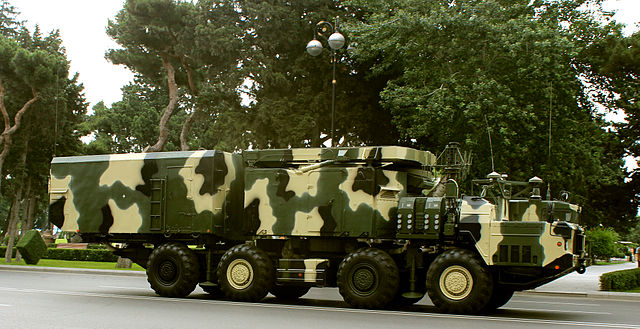 5p85 Vehicle in Azerbaidjan
5p85 Vehicle in Azerbaidjan
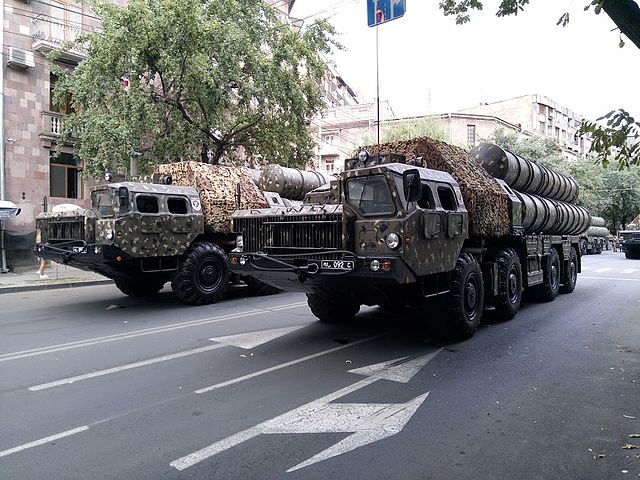 Armenian TEL
Armenian TEL
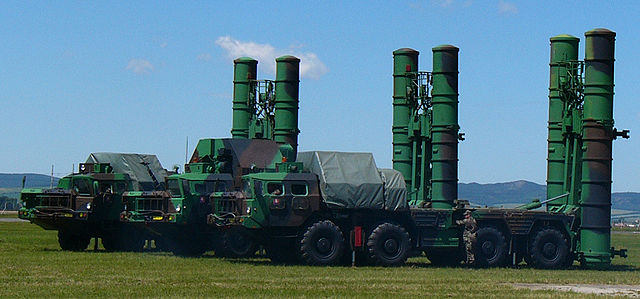 Slovak S-300 TEL
Slovak S-300 TEL
The vehicle was deployed in the ex-soviet republics, and many other countries such as Algeria, Armenia, Azerbaidjan, Belarus, Bulgaria, China, Egypt, Cyprus, Greece, India, Iran, Kazakhstan, Slovakia, Russia, Ukraine, and Vietnam. Others are debated like North Korea (They conducted tests with a system called 'KN-06'), Syria (An order for 6 systems signed in 2010), Venezuela (2 battalions of S-300VM "Antey-2500" delivered May 2012). Czechoslovakia had a single batallion, later passed on to Slovakia. East Germany operated at least two batallions but returned them to the USSR before re-unification.
5P85 In combat
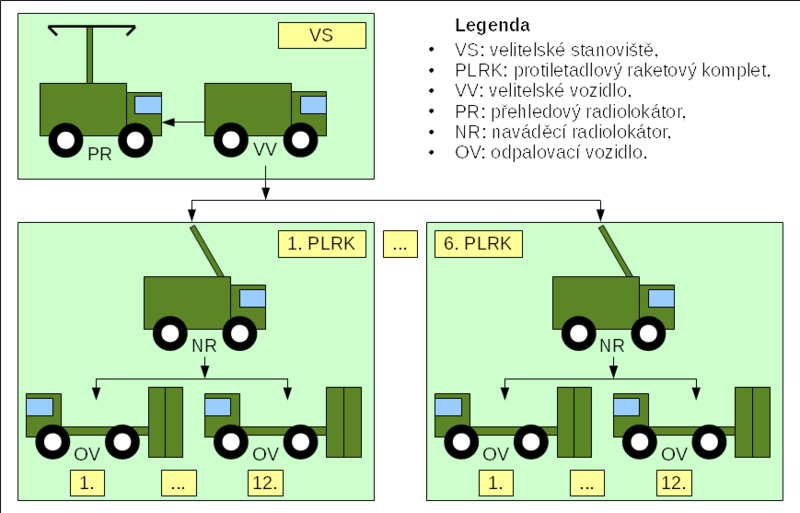 Unit structure
Unit structure
Since it's inception in 1978, this weapons system was provided organically to armoured divisions as a means of long range air protection, and each S-300 battalion includes up to 12 5P85ME missile launching vehicles, grouped by three vehicles each with a CiC vehicle. Each batallion also includes a support vehicle and several tracked control vehicles for low and high/long range altitude detection and a coordination CiC vehicle. By 1991- 1993 ballistic missiles were shot down in exercises, with 90% success. It was also shown able to shot down an UAV at 4.6 km and (simulated) a strategic bomber at 186 km. It could be also launch as a tactical ballistic missile up to 120 km, spraying on target up to 19,000-36,000 fragments depending on the type.
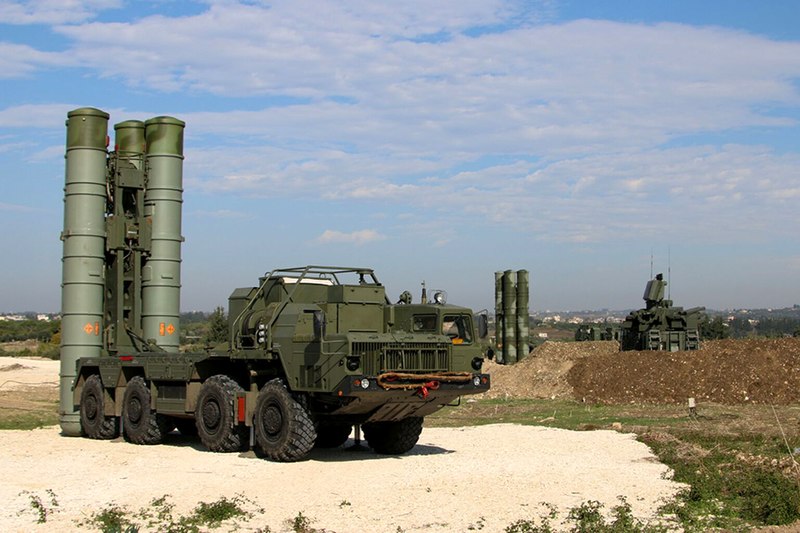
Deployed first in the Moskva Oblast, this weapons system was soon deployed mostly in western-based units and some Warsaw pact countries as well. A system on the march consists of the following vehicles:
-40V6M/M1/M2 mast assemblies for HF and TTR
-ChMAP/5P85-1 semi-trailer with 4 missile tubes for S-300P
-F-9 shelter unit for radar operators (S-300P/PM)
-5P85T trailer (towed by KRAZ-260 truck) with 4 missile tubes for S-300PM
-5P85SU TEL with 4 missile tubes and command post for S-300PMU
-5P85DU TEL with 4 missile tubes for S-300PMU
-1T12-2M site survey vehicle
-5T58 missile transport vehicle
-22T6 loading vehicle
-Baikal-1 command vehicle
-30N6 mounted on MAZ-543M heavy truck for S-300PMU
The system was deployed with the 5P85 TEL truck in Abkhazia in 2008, and famously all along the Russian military intervention in the Syrian civil war, 2020 Nagorno-Karabakh conflict and recently during the 2022 invasion of Ukraine were two were lost according to OSINT. The S-300 had been used with moderate success on both sides. Ukraine operated in the 2010s the S-300PT, S-300PS, S-300PMU, S-300V1 but only six systems were operational.
Read More/Src
astronautix.com
The 5p85TE2 trailer truck on armyrecognition.com
The 5p85SE on armyrecognition.com
5p85PMU-1 armyrecognition.com
5p85PMU on armyrecognition.com
The 5p85SU1 on armyrecognition.com
.srbijadanas.co
In Greek service
SA-10 Grumble tech (FR) pdf
rosbalt.ru/
missilery.info s300pmu
missilery.info s300v
The 48N6 missile on deagel.com
The 5p85 TEL on deagel.com
MAZ-7310 family
wiki S300 weapons system
CC photos
oryxspioenkop.com list of destroyed russian equipment OSINT
Videos
S-300 - Russian Long Range Air Defence Missile System
What is the S-300? A Detailed Look
S-300 live-fire drills - combat approved
3 reasons Russia is using the S300 for land attack in Ukraine